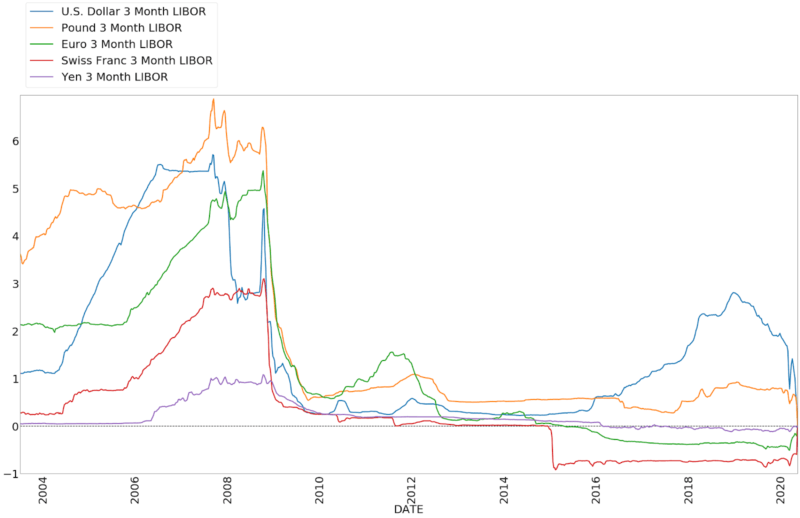Negative Interest Rates Explained

Last week the British government sold bonds with negative yields for the first time on record. While this was new territory for the U.K., the Bank of England joins a handful of other central banks in Europe, including the European Central Bank, in supporting negative interest rates. Negative interest rates have become a feature of the modern financial environment. Their persistence demands explanation.
At first glance, negative interest rates seem peculiar. Individuals typically value a gain in the present more than an equivalent gain in the future. Recognizing this positive time preference makes it easy to understand why borrowers pay interest to lenders for funds. It makes it difficult to understand why a lender would pay a borrower. But, contrary to our intuitions, negative rates need not imply a negative time preference.
In times of war, one might pay to leave goods in the safe hands of someone far away from the conflict. Suppose you pay a fee of $10,000 to store $1 million worth of goods for a year. Then, in a year, when the risk of destruction has passed, you return and collect your $1 million worth of goods. The storage fee in this case is effectively a negative interest payment. $1,010,000 was deposited. $1 million was retrieved. The implied interest rate is -0.99%. The negative rate in this case is not because one values the present less than the future. Rather, it is to limit the loss of value that would otherwise result.
The past is filled with examples of negative interest rates. Negative ex-post real rates – meaning returns realized by the investor after adjusting for inflation – are perhaps the most common. When financial markets underestimate inflation, the money used to repay loans is less valuable than was anticipated when the loan was made. In some cases, the unexpected reduction in the value of money is so large that the principal and interest lenders receive is worth less than the principal was worth when the loan was made. In these cases, ex-post real rates are negative, even though nominal and expected real rates were positive when the loan was made.
Negative nominal and expected real rates are less common and, until recently, were only observed under scenarios where the party lending at a negative rate was compensated or where the negative rate was short-lived. During the Great Depression, for example, nominal yields on some government securities were negative. But bondholders could profitably hold these instruments if they rolled them over into new securities at the end of their term.
Negative nominal and expected real rates have also been observed over relatively short periods, when financial markets are distressed. In a liquidity crisis, demand for short-term government bonds tends to rise as these assets are thought to be safe and liquid. Even if holding a government bond earns the holder a small or negative return, a fall in the bond’s yield, meaning a rise in its price, results in profit for the holder of the bond. Hence, banks expect these bonds might serve as a hedge against a downturn. During the 2008 financial crisis, and again in 2015, some short-term U.S. Treasuries traded at negative nominal and expected real yields.
In the last decade, many central banks in Europe have moved to a regime that targets negative nominal interest rates. The Swiss National Bank moved its target rate into negative territory in 2015. Rates targeted by the European Central Bank, the Bank of Japan, and the central bank of the Netherlands followed. Now monetary theorists must explain how negative nominal interest rates have persisted for years without any direct compensation to the lender.

Interest Rates Explained
Let’s start with the basics. Most probably think of interest rates in terms of lending money and receiving repayment of the sum lent along with interest. Economists think about interest rates in terms of returns on business ventures. Suppose that you purchase an orchard for $1 million and, one year later, generate an operating profit from the orchard of $100,000. Your $1 million investment yielded a return of 10%. If you sold the orchard for $1 million, you would retain the $100,000 in income, improving your total wealth to $1.1 million.
Suppose that, instead of purchasing the orchard outright, you borrowed the $1 million at a 5% interest rate. After earning $100,000 in operating profit, selling the orchard for $1 million, and repaying the principal ($1 million) and interest ($50,000), you are left with a net profit of $50,000.
So long as business ventures are expected to yield positive returns, entrepreneurs are willing to pay a positive interest rate to acquire a loan. Their willingness to pay is limited by the expected return on their venture. The higher the rate of return on business ventures, the more an entrepreneur will be willing to pay a lender for the funds required to realize that return. Hence, interest rates will tend to rise and fall with the expected return on marginal business ventures.
Conventional Interest Rate Targeting
Traditional monetary policy can influence nominal interest rates in the long run, by raising or lowering the rate of inflation. But its effects on the real interest rate are limited to the short run. If the central bank pushes real interest rates too low, it generates a boom in the short run. The inflation rate and nominal interest rates then rise as borrowers and lenders come to expect higher inflation. Correspondingly, if the central bank pushes real rates too high, it generates a contraction in the short run. The inflation rate and nominal interest rates then fall as borrowers and lenders come to expect lower inflation. In the long run, however, real interest rates adjust to clear the market.
For much of the history of central banking, monetary policy tended to be set through either the discount window or through open market operations. When the central bank lent to banks through the discount window, it charged the bank a positive rate of interest. To lend at a negative interest rate would cost the central bank and encourage the borrowing bank to behave irresponsibly.
When the central bank conducted monetary policy through open market operations, it purchased (or sold) assets in financial markets. Typically, the central bank purchased bonds to support government borrowing, lowering yields on those bonds relative to yields on other bonds for a short period of time. Although it might push those yields into negative territory, it is limited in its ability to do so. Those holding the sovereign bonds the central bank sought to buy were typically motivated to sell before the price exceeded its face value. And, even if it were to temporarily push those yields below zero, rising inflation expectations would generally cause investors to demand higher nominal interest rates to compensate for a fall in the inflation-adjusted value of repayment.
Unconventional Interest Rate Targeting
The key to understanding more recent efforts to target negative interest rates is to recognize that a regime change has occurred. Central banks now adjust the supply of base money and influence the demand for money. Under the old regime, an increase in the quantity of money would promote inflation and higher nominal interest rates because the demand for base money was left more or less unchanged. Now, the central bank can adjust the rate of interest it pays to banks holding reserves in excess of those they are required to hold by law. The higher the rate paid on excess reserves relative to other rates in the market, the more inclined banks are to hold the money on account at the central bank rather than lending that money out in the market, where it would eventually drive up prices.
Ben Bernanke explains the strategy with surprising clarity:
You might ask, ‘The Fed is buying two trillion dollars’ worth of securities. How do we pay for that?’ The answer is that we paid for those securities by crediting the bank accounts of the people who sold them to us. And those accounts at the banks showed up as reserves that the banks would hold with the Fed. . . [T]he amount of currency in circulation has not been affected by these activities.” (105, 106)
This new policy of paying interest on excess reserves has broken the link between the quantity of money created by a central bank and the price level that would otherwise result from expenditures supported by that money. If the demand to hold base money increases to the same extent as the increase in the monetary base, the new money does not result in new loans. That means there are no new loans to drive up spending and, with it, prices.
Central banks can use interest payments on excess reserves to sterilize asset purchases. They can also use them to control inflation and the level of nominal interest rates. In the U.S., the Federal Reserve sets the rate paid on excess reserves in line with its target for the effective federal funds rate—that is, the rate banks charge each other for overnight loans. If the rate paid on excess reserves is higher than the observed federal funds rate, lending activity in the overnight lending market is greatly reduced, since funds that would normally enter that market are instead parked at the Federal Reserve to collect the premium.
Negative Interest Rate Policy
The new operating regime permits the central bank to target negative nominal interest rates. If the central bank pays a negative nominal rate on excess reserves, it discourages banks from holding excess reserves. That pushes funds out of the central bank and into the market. It may choose to pay a negative nominal rate on all excess reserves or merely on excess reserves above some threshold. In either case, the effect is to lower short-term nominal lending rates, as the relevant alternative (nominal interest payments on a marginal increase in excess reserves) is less than zero.
So long as positive-nominal-rate-of-return projects are available, paying negative nominal interest on excess reserves will not generally push other nominal interest rates below zero. Banks will lend out excess reserves until they only hold those required by law; and, since the business ventures funded enjoy a positive nominal rate of return, entrepreneurs will be willing to pay a positive nominal rate to borrow.
When coupled with legal restrictions, however, a negative nominal interest rate policy can push other short-term nominal rates below zero. If banks cannot lend freely, but are instead required to hold specific assets like government bonds, they might bid the prices of those assets up above their face value, thereby implying a negative expected real rate on those assets. And, if expected inflation is sufficiently low, nominal rates on those assets will be negative as well. Furthermore, the negative nominal and expected real rates on those assets might remain negative, so long as the legal restrictions generating them are as binding.
The legal restrictions view seems to explain the negative nominal and expected real interest rates observed in the last few years. Under Basel III regulations, banks are required to allocate a portion of their investment portfolio to fulfill the liquidity coverage ratio requirement. Basel III requires that banks hold supposedly safe Level 1 assets, which includes sovereign debt and common stock. The highest quality sovereign debt receives an official risk weighting of 0% and is considered to be highly liquid for this purpose. Left with a choice between holding sovereign debt, common stock, coin, or other assets of brief maturity, banks often fulfill their Level 1 asset requirements by holding bonds from the domestic government.
A bank wishing to must hold liquid capital whose value is equal to at least 30 days of cash requirements needed during a stress test. From the bank’s perspective, acquiring Level I capital essentially amounts to a cost of doing business. It would much rather acquire only those assets with higher risk-adjusted rates of return. But it is not permitted to do so. In order to acquire any assets with higher risk-adjusted rates of return, it must also acquire so-called safe assets with lower, and potentially negative, risk-adjusted rates of return. In essence, banks pay a tax by holding sovereign debt as they make payments to the borrowing government.
Basel III capital requirements help explain why negative nominal and expected real interest rates have become a persistent feature of financial markets. By holding government bonds, banks are simultaneously paying for a highly liquid hedge—recall that the price of these safe assets tends to be counter-cyclical—and fulfilling Basel III liquidity coverage ratio requirements. When central banks push the nominal interest rate paid on excess reserves below zero, banks attempt to reduce their reserve holdings by making loans. To the extent that banks must acquire sovereign debt in order to make positive-expected-real-rate-of-return loans, they bid up the price of sovereign debt, potentially above face value. As such, the central bank’s negative interest rate policy, coupled with Basel III regulations, can push the nominal and expected real rates paid on AAA-rated government debt below zero.














